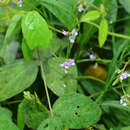Habitat
provided by EOL authors
Geobotanical studies for Russian part of wild soybean distribution allowed the identification of four types of associations in which wild soybean is met. 1. The first group is pioneer phytocenoses. Such associations spread along freshly flooded riverbeds, on sand and shingle spits, and on anthropogenic grounds. They may include slopes of new and rebuilt roads, landslips, and sand pits, as well as road ditches with temporary streams. The most characteristic difference of such phytocenoses is a predominance of weed species, with over half of them being annual and biennial weeds. 2. The second group of associations occupies watersheds and terraces. For this group, a pioneer-like character, though secondary, is also typical. Phytocenoses of the second group develop at sites of destroyed or severely disturbed natural vegetation. These are wastelands, dumps, abandoned fields and gardens, and strips along roads (slopes and ditches). As compared with the associations of the first group, weeds are also in abundance, but the count of annual and biennial weeds is low. The vitality of wild soybean in associations of the second group is high, but its share decreases as interspecies rivalry increases. 3. Associations of the third group occupy flooded river areas and the lower parts of watersheds with temporary streams. The share of weedy species within these associations is considerably smaller than within the first and second types, for their growth is obstructed by a thick grass mass and soil turfing. Wild soybean is rarely met in meadow associations. With anthropogenic intervention, its projective coverage may increase. If a meadow’s grass mass is completely undisturbed, soybean wholly disappears or is heavily depressed and hardly noticeable. 4. The fourth group of associations—little-disturbed grassy associations of watersheds. This group’s associations experience a weak anthropogenic impact. The share of young annuals is minimal. Soybean is rare (from Nedoluzhko & Dorokhov, 2007).
Distribution
provided by EOL authors
Wild soybean are distributed in East Asia, including modern Russia (Far East of Russia), China, Taiwan, Japan and Korea (Skvortsov, 1927; Komarov, 1958; Kharkevich, 1989; Seferova, 2001; Lu, 2004). The China is a major center of diversity for wild soybeans. Glycine max subsp. soja are distributed in area from about 24 degree north (middle-northern Guangdong Province and Guangxi Zhuang Autonomous Regions) in the south to 53 degree north (Heilongjiang River valley) in the northern China, and that there was no wild soybean to find in three regions Xinjiang, Qinghai and Hainan. The area of 30 to 45 degree north was a diverse region of the wild soybean in China, where the wild soybean has an extensive distribution, large populations and rich types. The highest point of wild soybean distribution in China was 2670 m, locating at 27 degree 30` north, Ninglang County, Yunnan Province (Xu B., 1989; K. Wang et al., 2001).
Glycine max subsp. soja genome sequence
provided by EOL authors
Whole genome of Glycine max subsp. soja was published by South Korea research team at 2010 (Kim et al., 2010). This research group has reported the genome sequence of wild soybean (in particular, G. soja var. IT182932) in PNAS. Korean scientists have generated the 48.8-Gb data by Illumina Genome Analyzer (Illumina-GA). They have aligned short Illumina reads to the Glycine max subsp. max reference genome and a consensus was determined for G. soja. This consensus sequence spanned 915.4 Mb, representing a coverage of 97.65% of the G. max published genome sequence and an average mapping depth of 43-fold. The nucleotide sequence of the G. soja genome, which contains 2.5 Mb of substituted bases and 406 kb of small insertions/deletions relative to G. max, is ∼0.31% different from that of G. max. In addition to the mapped 915.4-Mb consensus sequence, 32.4 Mb of large deletions and 8.3 Mb of novel sequence contigs in the G. soja genome were also detected. Nucleotide variants of G. soja versus G. max confirmed by Roche Genome Sequencer FLX sequencing showed a 99.99% concordance in single-nucleotide polymorphism and a 98.82% agreement in insertion/deletion calls on Illumina-GA reads. Data presented in this study suggest that the G. soja/G. max complex may be at least 0.27 million y old, appearing before the relatively recent event of domestication (6,000∼9,000 y ago). This suggests that soybean domestication is complicated and that more in-depth study of population genetics is needed.
- bibliographic citation
- Moon Young Kim, Sunghoon Lee, Kyujung Van, Tae-Hyung Kim, Soon-Chun Jeong, Ik-Young Choi, Dae-Soo Kim, Yong-Seok Lee, Daeui Park, Jianxin Ma, Woo-Yeon Kim, Byoung-Chul Kim, Sungjin Park, Kyung-A Lee, Dong Hyun Kim, Kil Hyun Kim, Jin Hee Shin, Young Eun Jang, Kyung Do Kim, Wei Xian Liu, Tanapon Chaisan, Yang Jae Kang, Yeong-Ho Lee, Kook-Hyung Kim, Jung-Kyung Moon, Jeremy Schmutz, Scott A. Jackson, Jong Bhak, and Suk-Ha Leeai. Whole-genome sequencing and intensive analysis of the undomesticated soybean (Glycine soja Sieb. and Zucc.) genome // PNAS. 2010. V. 107(51). p. 22032–22037.
- author
- Artem Nedoluzhko (nedoluzhko)
Glycine soja
provided by wikipedia EN
Glycine soja, known as wild soybean, is an annual plant in the legume family. It may be treated as a separate species, the closest living relative of the cultivated soybean, Glycine max, an important crop,[2] or as a subspecies of the cultivated soybean, Glycine max subsp. soja.[1]
The plant is native to eastern China, Japan, Korea and far-eastern Russia.[2]
References

- license
- cc-by-sa-3.0
- copyright
- Wikipedia authors and editors
Glycine soja: Brief Summary
provided by wikipedia EN
Glycine soja, known as wild soybean, is an annual plant in the legume family. It may be treated as a separate species, the closest living relative of the cultivated soybean, Glycine max, an important crop, or as a subspecies of the cultivated soybean, Glycine max subsp. soja.
The plant is native to eastern China, Japan, Korea and far-eastern Russia.
- license
- cc-by-sa-3.0
- copyright
- Wikipedia authors and editors

